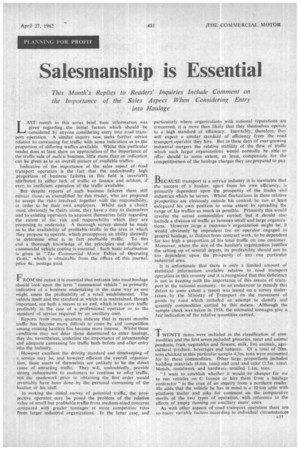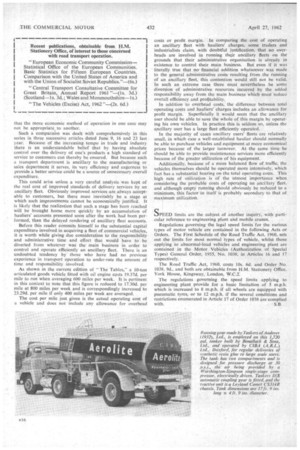Salesmanship is Essential
Page 73

Page 74

If you've noticed an error in this article please click here to report it so we can fix it.
This Month's Replies to Readers' Inquiries Include Comment on the Importance of the Sales Aspect When Considering Entry into Haulage
LAST month in this series brief basic information was given regarding the initial factors which should be considered by anyone considering entry into road transport operation. A similar inquiry now, seeks further advice relative to canvassing for traffic with some indication as to the proportion of differing traffics available. Whilst this particular reader does at least show an appreciation of the importance of the traffic side of such a business, little more than an indication can be given as to an overall picture of available traffics.
Indicative of the importance of the sales aspect of road transport operation is the fact that the undoubtedly high proportion of business failures in this field is invariably attributed to either lack of traffic or finance and seldom, if ever, to inefficient operation of the traffic available.
But despite reports of such business failures there still remain those, as exemplified by this reader, who are prepared to accept the risks involved, together with the responsibility, in order to be their own employers. Whilst such a choice must obviously be theirs alone, they have a duty to themselves and to existing operators to acquaint themselves fully regarding the extent of the risk and responsibility which they are proposing to undertake. A thorough survey should be made as to the availability of profitable traffic in the area in which they propose to operate, which presupposes an ability shrewdly to determine what is in fact profitable traffic. To this end a thorough knowledge of the principles and details of commercial vehicle costing is essential. Such basic information is given in "The Commercial Motor Tables of Operating Costs," which is obtainable from the offices of this journal, price 4s., postage paid.
FROM the outset it is essential that entrants into road haulage should look upon the term " commercial vehicle as primarily indicative of a business undertaking in the same way as one might assess the profitability of a retail establishment. The vehicle itself and the standard at which it is maintained, though important, are both a means to an end, which is to carry traffic profitably in the case of a professional operator or to the standard of service required by an ancillary user.
Reports from many quarters indicate that in recent months traffic has become more difficult to come by and competition among existing hauliers has become more intense. Whilst these conditions may not deter those determined to enter haulage, they do, nevertheless, underline the importance of salesmanship and adequate canvassing for traffic both before and after entry into the industry.
However excellent the driving standard and timekeeping of a service may be, and however efficient the overall organization, these assets of themselves are unlikely to be the direct cause of attracting traffic. They will, undoubtedly, provide strong inducements to customers to continue to offer traffic, but the spadework prior to obtaining the first order would invariably have been done by the personal canvassing of the haulier or his staff.
In making the initial survey of potential traffic, the prospective operator may be posed the problem of the relative value of small but profitable traffic from medium-sized concerns compared with greater tonnages at more competitive rates from larger industrial organizations. In the latter case, and
particularly where organizations with national reputations are concerned, it is more than likely that they themselves operate to a high standard of efficiency. Inevitably, therefore, they will expect a similar standard of efficiency from the road transport operator they hire. But in these days of ever-growing industrial mergers the relative stability of the flow of traffic which such larger organizations would normally be able to offer should to some extent, at least, compensate for the competitiveness of the haulage charges they are prepared to pay.
BECAUSE transport is a service industry it is inevitable that the success of a haulier, apart from his own efficiency, is primarily dependent upon the prosperity of the trades and industries which he serves. Whilst fluctuations in these relative prosperities are obviously outside his control, he can at least safeguard his own position to some extent by spreading the range of his traffics as much as possible. Primarily this would involve the actual commodities carried, but it should also include a division of traffic as between small and large organizations. However large a customer's organization might be, it would obviously be imprudent for an operator engaged in general haulage, as distinct from contract work, to be dependent for too high a proportion of his total traffic on one customer. Moreover, where the size of the haulier's organization justifies the setting up of several depots, its profitability should not be too dependent upon the prosperity of any one particular industrial area.
It is unfortunate that there is only a limited amount of statistical information available relative to road transport operation in this country and it is recognized that this deficiency is not in keeping with the importance of this means of transport in the national economy. In an endeavour to remedy this defect to some extent a report was issued on a survey undertaken by the Ministry of Transport on the movement of goods by road which included an attempt to classify and quantify commodities carried by this means. Although the sample check was taken in 1958, the estimated tonnages give a fair indication of the relative quantities carried.
TWENTY items were included in the classification of commodities and the first seven included gfoceries, meat and animal products, fruit, vegetables and flowers, milk, live animals, agricultural produce, beverages and tobacco. Of a total of 20m. tons checked in this particular sample 4.3m. tons were accounted for by these commodities. Other large proportions included building materials (6.6m. tons) and coal and coke (2.5m. tons). Metals, metalwork and hardware totalled 1.1m. tons.
"1 want to establish whether it would be cheaper for me to run vehicles on C licence or hire them from a haulage contractor" is the crux of an inquiry from a northern reader. He adds that the vehicle he has in mind is a 10-ton artic with platform trailer and asks for comment on the comparative merits of the two types of operation, with reference to the effects of empty running on ancillary users' costs.
As with other aspects of road transport operation there are so many variable factors according to individual circumstances rd 5
that the more economic method of operation in one case may not be appropriate, to another.
. Such a comparison was dealt with comprehensively in this series in three successive articles dated June 9, 16 and 23 last year. Because of the increasing tempo in trade and industry there is an understandable belief that by having absolute control over the delivery of one's products a high standard of service to customers can thereby be ensured. But because such a transport department is ancillary to the manufacturing or sales department it serves, its very efficiency and eagerness to provide a better service could be a source of unnecessary overall expenditure.
This could arise unless a very careful analysis was kept of the real cost of improved standards of delivery services by an ancillary fleet. Obviously improved services are always acceptable to customers, but there must inevitably be a stage at which such improvements cannot be economically justified. It is likely that the realization that such a stage has been reached will be brought home more quickly by an accumulation of hauliers' accounts presented soon after the work had been performed, than the delayed rendering of ancillary fleet accounts.
Before this reader commits himself to the substantial capital expenditure involved in acquiring a fleet of commercial vehicles, it is worth while giving due consideration to the responsibility and administrative time and effort that would have to be diverted from whatever was the main business in order to control and operate efficiently an ancillary fleet. There is an undoubted tendency by those who have had no previous experience in transport operation to under-rate the amount of time and responsibility involved.
As shown in the current edition of "The Tables," a 10-ton articulated goods vehicle fitted with oil engine costs 19.37d, per mile to run when averaging 600 miles per week. It is pertinent in this context to note that this figure is reduced to 17.30d. per mile at 800 miles per week and is correspondingly increased to 23.29d. per mile if only 400 miles per week are averaged.
The cost per mile just given is the actual operating cost of a vehicle and does notinclude any allowance for overhead costs or profit margin. In comparing the cost of operating an ancillary fleet with hauliers' charges, some traders and industrialists claim, with doubtful justification, that no overheads are involved in running their ancillary fleets on the grounds that their administrative organisation is already in existence to control their main business. But even if it was literally true that no financial addition whatsoever was made to the general administrative costs resulting from the running of an ancillary fleet, this contention would still not be valid. In such an extreme case there must nevertheless be some diversion of administrative resources incurred by the added responsibility away front the main businesa which must reduce overall efficiency and profitability.
In addition to overhead costs, the difference between total operating costs and hauliers' charges includes an allowance for profit margin. Superficially it would seem that the ancillary user should be able to save the whole of this margin by operating his own vehicles. In practice this is seldom so, unless the ancillary user has a large fleet efficiently operated.
In the majority of cases ancillary users' fleets are relatively small, in which case a well-established haulier should normally be able to purchase vehicles and equipment at -more economical prices because of the larger turnover. At the same time he should be able to provide maintenance services more efficiently because of the greater utilization of his equipment.
Additionally, because of a more balanced flow of traffic, the vehicles themselves should be operated more intensively, which fact has a substantial bearing on the total operating costs. This high rate of utilization is of the 'utmost importance when considering the probable costs of operating an ancillary fleet,and although empty running should obviously be reduced to a minimum, this factor' in itself is probably secondary to that of maximum utilization.
'SPEED limits are the subject of another inquiry, with particular reference to engineering plant and mobile cranes.
Regulations .governing the legal speed limits for the various types of motor vehicle are contained in the following Acts or Orders. The First Schedule of the Road Traffic Act, 1960, sets out the limits for most normal types of vehicle, whilst those applying to abnormal-load vehicles and engineering plant are contained in the Motor Vehicles (Authorization of Special Types) General Order, 1955, No. 1038, in Articles 16 and 17 respectively.
The Road Traffic Act, 1960, costs 10s. 6d. and Order No. 1038, 9d.. and both are obtainable from 11.-M. Stationery Office. York House, Kingsway, London, W.C.2.:
The regulations governing the speed limits applying to engineering plant provide for a basic limitation of 5 rn.p.h. which is increased to 8 m.p.h. if all wheels are equipped with pneumatic tyres, or to 12 m.p.h. if the several conditions and restrictions enumerated in Article 17 of Order 1038 are'complied
with. S.B.




















































































































